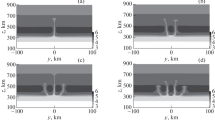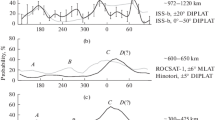Abstract
Ground-based and satellite measurements, as well as numerical modeling of the spatial structure of the equatorial ionospheric bubbles are carried out quite intensively. These data show that the longitudinal and altitudinal gradients of the logarithm of the electron concentration at the vertical boundaries of the bubbles can reach values of 0.001 1/m and 0.0001 1/m, respectively. With such gradients of electron concentration, the development of a gradient-drift instability (GDI) is possible. This instability can generate ionospheric plasma irregularities with space-time scales characteristic of equatorial F-scattering. This article presents the results of calculating the growth rates of the GDI at the boundaries of ionospheric bubbles. The space-time structure of equatorial plasma bubbles (EPBs) is obtained by numerical simulation. This simulation is based on a two-dimensional numerical model of the Rayleigh–Taylor instability in the Earth’s equatorial ionosphere. This model was constructed under the condition that the Rayleigh-Taylor and gradient inhomogeneities are strongly elongated along the magnetic field lines. The growth rates of the gradient-drift plasma instability are obtained from the dispersion equation. The results of numerical experiments confirm the possibility of generating the GDI of the ionospheric plasma. This is due to significant longitudinal and altitudinal plasma gradients at the fronts of the developed EPB. In this case, the growth rate of the GDI can reach values of 1/(170 s). The GDI can cause equatorial F-scattering.





Similar content being viewed by others
REFERENCES
D. T. Farley, B. B. Balsley, R. F. Woodman, and J. P. McClure, “Equatorial spread F: Implications of VHF radar observations,” J. Geophys. Res. 75 (34), 7199–7216 (1970).
B. W. Reinisch, M. Abdu, I. Batista et al., “Multistation digisonde observations of equatorial spread F in South America,” Ann. Geophys. 22, 3145–3153 (2004).
J. Röttger, “The macro-scale structure of equatorial spread-F irregularities,” J. Atmos. Terr. Phys. 38 (1), 97–101 (1976).
S. Saito, T. Maruyama, M. Ishii et al., “Observations of small- to large-scale ionospheric irregularities associated with plasma bubbles with a transequatorial HF propagation experiment and spaced GPS receivers,” J. Geophys. Res. 113 (A12), A12313, 1–10 (2008).
R. F. Woodman, “Spread F – an old equatorial aeronomy problem finally resolved?,” Ann. Geophys. 27, 1915–1934 (2009).
S. V. Matsievskii, N. M. Kashchenko, and M. A. Nikitin, “Ionospheric bubbles: Ion composition, velocities of plasma motion and structure,” Radiophys. Quantum Electron. 32 (11), 969–974 (1989).
J. D. Huba, G. Joyce, and J. Krall, “Three-dimensional modeling of equatorial spread F,” in Aeronomy of the Earth’s Atmosphere and Ionosphere, Ed. by M. Abdu and D. Pancheva, IAGA Special Sopron Book Series (Springer, Dordrecht, 2011), Vol. 2, pp. 211–218.
S. L. Ossakow and P. K. Chaturvedi, “Morphological studies of rising equatorial spread F bubbles,” J. Geophys. Res. 83 (A5), 2085–2090 (1978).
W. B. Hanson, W. R. Coley, R. A. Heelis, and A. L. Urquhart, “Fast equatorial bubbles,” J. Geophys. Res. 102 (A2), 2039–2045 (1997).
DMSP 5D-2/F10/NASA Space Science Data Coordinated Archive. URL: https://nssdc.gsfc.nasa.gov/nmc/spacecraft/displayTrajectory.action?id=1990-105A
Yu. A. Sukovatov, “Numerical modeling of two-dimensional nonlinear gradient-drift instability in the outer ionosphere,” Izv. Altai. Gos. Univ., No. 1–2, 168–171 (2011).
Yu. A. Sukovatov, “The theoretical study on nonlinear gradient-drift instability in the outer ionosphere,” Ibid, No. 1–1, 222–225 (2012).
N. M. Kashchenko, S. A. Ishanov, and S. V. Matsievsky, “Rayleigh-Taylor instability development in the equatorial ionosphere and a geometry of an initial irregularity,” Math. Models Comput. Simul. 11 (3), 341–348 (2019).
A. E. Hedin, J. E. Salah, J. V. Evans et al., “A global thermospheric model based on mass spectrometer and incoherent scatter data MSIS, 1. N2 density and temperature,” J. Geophys. Res. 82 (16), 2139–2147 (1977).
A. E. Hedin, C. A. Reber, G. P. Newton et al., “A global thermospheric model based on mass spectrometer and incoherent scatter data MSIS, 2. Composition,” Ibid, 2148–2156 (1977).
M. E. Ladonkina, O. A. Neklyudova, V. F. Tishkin, and V. S. Chevanin, “A version of essentially nonoscillatory high-order accurate difference schemes for systems of conservation laws,” Math. Models Comput. Simul. 2 (3), 304–316 (2010).
A.V. Safronov, “Accuracy estimation and comparative analysis of difference schemes of high-order approximation,” Vychisl. Metody Program. (Numer. Methods Program.) 11 (1), 137–143 (2010).
Funding
This study was financially supported by the Russian Foundation for Basic Research, project 20-01-00361.
Author information
Authors and Affiliations
Corresponding authors
Rights and permissions
About this article
Cite this article
Kashchenko, N.M., Ishanov, S.A. & Matsievsky, S.V. Numerical Study of the Gradient-Drift Instability’s Growth Rate at the Fronts of Equatorial Plasma Bubbles. Math Models Comput Simul 13, 623–630 (2021). https://doi.org/10.1134/S2070048221040141
Received:
Revised:
Accepted:
Published:
Issue Date:
DOI: https://doi.org/10.1134/S2070048221040141




